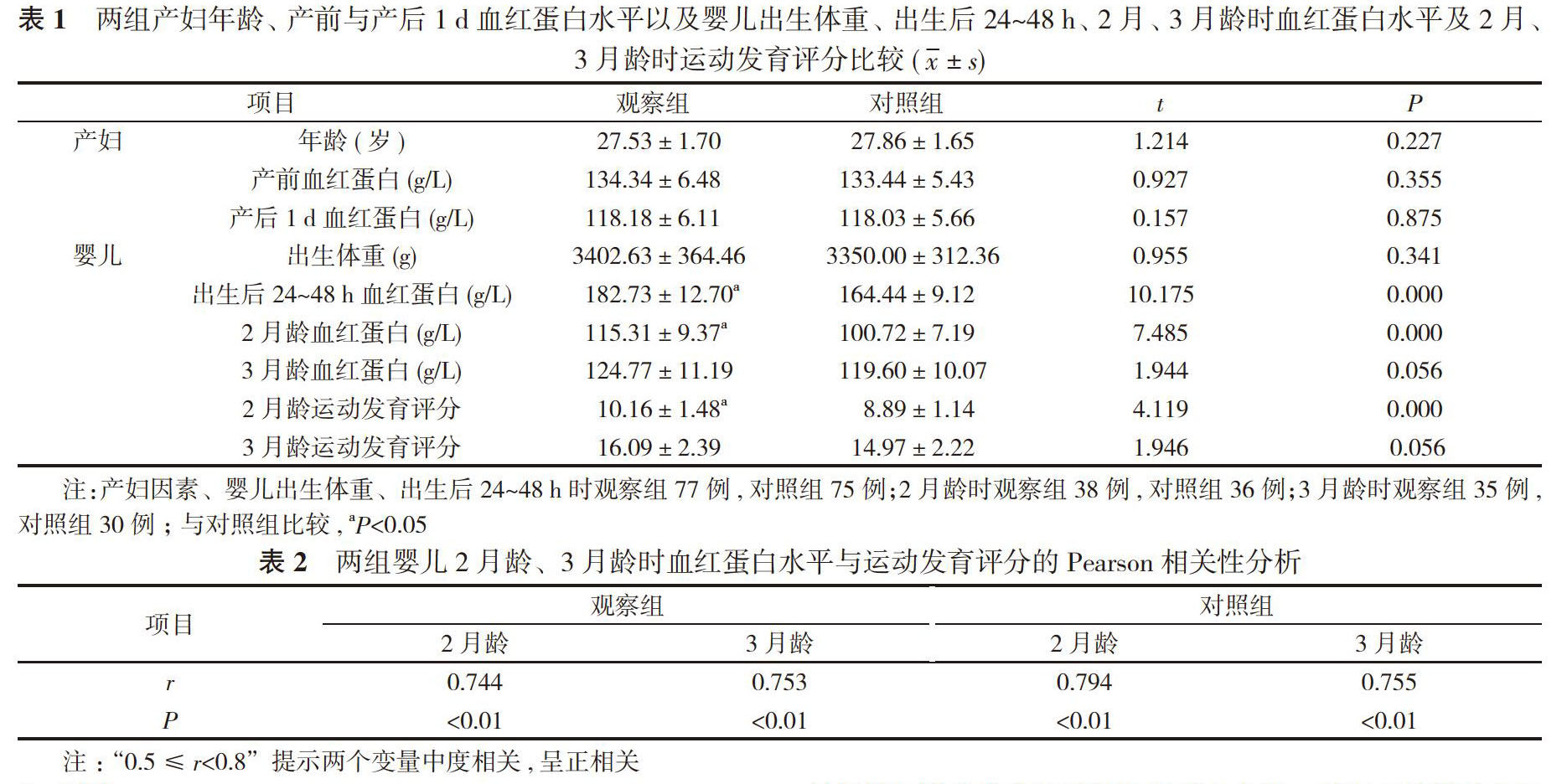 对照组(双数, 75例)。观察组在胎儿娩出后120~135 s结扎脐带, 在延迟结扎脐带期间将胎儿保暖后置低于胎盘10 cm的位置;对照组在胎儿娩出后30 s内结扎脐带。比较两组产妇年龄、产前血红蛋白水平、产后1 d血红蛋白水平;比较两组婴儿出生体重、出生后24~48 h、2月龄、3月龄时血红蛋白水平以及2月龄、3月龄时运动发育水平。结果 观察组婴儿出生后24~48 h血红蛋白水平(182.73±12.70)g/L高于对照组的(164.44±9.12)g/L, 差异有统计学意义(P<0.05);观察组婴儿2月龄时血红蛋白水平及运动发育评分均高于对照组, 差异有统计学意义(P<0.05);观察组3月龄时血红蛋白水平及运动发育评分略高于对照组, 但差异无统计学意义(P>0.05)。两组婴儿2月龄及3月龄时血红蛋白水平与运动发育水平呈正相关性(P<0.01)。结论 延迟结扎脐带能减少婴儿缺铁性贫血的发生, 有利于婴儿的运动发育, 促进脑发育。
对照组(双数, 75例)。观察组在胎儿娩出后120~135 s结扎脐带, 在延迟结扎脐带期间将胎儿保暖后置低于胎盘10 cm的位置;对照组在胎儿娩出后30 s内结扎脐带。比较两组产妇年龄、产前血红蛋白水平、产后1 d血红蛋白水平;比较两组婴儿出生体重、出生后24~48 h、2月龄、3月龄时血红蛋白水平以及2月龄、3月龄时运动发育水平。结果 观察组婴儿出生后24~48 h血红蛋白水平(182.73±12.70)g/L高于对照组的(164.44±9.12)g/L, 差异有统计学意义(P<0.05);观察组婴儿2月龄时血红蛋白水平及运动发育评分均高于对照组, 差异有统计学意义(P<0.05);观察组3月龄时血红蛋白水平及运动发育评分略高于对照组, 但差异无统计学意义(P>0.05)。两组婴儿2月龄及3月龄时血红蛋白水平与运动发育水平呈正相关性(P<0.01)。结论 延迟结扎脐带能减少婴儿缺铁性贫血的发生, 有利于婴儿的运动发育, 促进脑发育。
【关键词】 延迟结扎脐带;缺铁性贫血;婴儿;运动发育
DOI:10.14163/j.cnki.11-5547/r.2019.34.007
Effect of delayed ligation of umbilical cord on anemia and motor development in infants WANG Xiang-ye,
WAN Jun, LING Li, et al. Department of Pediatrics, Jiangyin People’s Hospital, Jiangyin 214400, China
【Abstract】 Objective To discuss the effect of delayed ligation of umbilical cord on anemia and motor development in infants. Methods A total of 152 infants were divided into observation group (odd number,
77 cases) and control group (even number, 75 cases) by admission order. In the observation group, the cord was ligated 120-135 s after delivery, and the fetus was kept warm and placed 10 cm lower than the placenta during delayed cord ligation; in the control group, the cord was ligated 30 s after delivery. Comparison was made on age, prenatal hemoglobin level, hemoglobin level at 1 d after postpartum, birth weight, hemoglobin level at 24-48 h, 2-month and 3-month after postpartum, and motor development level at 2-month and 3-month of age between the two groups. Results The hemoglobin level at 24-48 h after postpartum (182.73±12.70) g/L in the observation group was higher than (164.44±9.12) g/L in the control group, and the difference was statistically significant (P<0.05). The hemoglobin level and motor development score at 2-month of age in the observation group was higher than those in the control group, and the difference was statistically significant (P<0.05). The hemoglobin level and motor development score at 3-month of age in the observation group was a little higher than those in the control group, but the difference was not statistically significant (P>0.05). There was a positive correlation between hemoglobin level and motor development level at 2 and 3 months of age in the two groups (P<0.01). Conclusion Delayed ligation of umbilical cord can reduce the occurrence of iron-deficiency anemia, promote the development of motor and brain.
【Key words】 Delayed ligation of umbilical cord; Iron-deficiency anemia; Infants; Motor development
儿童缺铁性贫血在全球范围内均有发生, 婴幼儿期由于其生长发育迅速, 对铁的需求量大, 故以婴幼儿期发病为主。在我国2岁以下婴幼儿贫血问题尤为突出, 2010年流行病学调查显示, 6~24月龄农村儿童贫血患病率高达20.0%以上, 其中缺铁性贫血占大多数。铁的缺乏可以影响到儿童各器官的生长发育和免疫功能, 同时对儿童的神经系统和精神行为的发育亦有较大影响[1-3]。近几十年来, 关于铁缺乏对人体中枢神经系统影响的研究越来越多, 有些研究[4, 5]更是提示了婴儿期的慢性铁缺乏对儿童的神经系统发育存在长期的影响, 可影响至青春期。引起铁缺乏的原因有很多, 比如低出生体重儿、未及时添加富铁辅食、经济情况等[6-8], 在早期改善婴儿的缺铁性贫血显得尤为重要。延迟结扎脐带作为一种便宜的生理性输血方法, 在20世纪50年代就已经被提出[9, 10], 其能有效地预防婴幼儿期的缺铁性贫血的发
生[11-15]。我国仅有少许文献指出[16, 17], 延迟结扎脐带能够增加新生儿早期血容量, 减少婴儿早期贫血的发生。本研究采用随机对照试验, 比较延迟结扎脐带与较早结扎脐带两种方法对正常足月新生儿出生后24~48 h、2月龄及3月龄时血红蛋白情况及运动发育水平的影响, 现报告如下。
1 资料与方法
1. 1 一般资料 选取2017年10月~2018年9月于本院产科住院的孕妇共200例, 因产后大出血、产程异常、新生儿窒息、先天性疾病、感染性疾病等原因, 入选婴儿共152例, 依据住院时间顺序分为观察组(单数, 77例)和对照组(双数, 75例);因喂养、失访等原因, 2月龄时入选婴儿共74例, 其中观察组38例, 对照组36例;3月龄时入选婴儿共65例, 其中观察组35例, 对照组30例。
孕妇入选条件:孕妇年龄25~30岁, 无长期饮酒抽烟等嗜好;无慢性血液系统等疾病;非长期服药患者(抗精神病药、甲状腺激素、胰岛素、糖皮质激素、细胞毒性药物等);正常妊娠(未合并高血压、胆汁淤积、糖尿病、心脏病、哮喘、先兆子痫、贫血、胎膜早破时间长或有感染迹象);无化学药品接触史;分娩期间未使用麻醉剂、镇痛剂、催产素、激素等;孕母血型排除O型;单胎妊娠;孕期在38~41周。
婴儿入选条件:孕期在38~41周顺产分娩的正常足月儿, 排除先天性疾病、感染性疾病、视听觉发育异常、肌张力异常等疾病因素;母乳喂养;父亲无嗜烟、嗜酒等不良习惯。
1. 2 方法 观察组进行知情同意告知并签字, 胎儿娩出后120~135 s结扎脐带, 在延迟结扎脐带期间将胎儿保暖后置低于胎盘10 cm位置;对照组按常规胎儿娩出后30 s内结扎脐带。因存在产程异常、出现窒息、产后大出血、先天性疾病、感染性疾病者退出研究。
1. 3 观察指标及判定标准 比较两组产妇年龄、产前血红蛋白水平、产后1 d血红蛋白水平;比较两组婴儿出生体重、出生后24~48 h、2月龄及3月龄时血红蛋白水平, 对于2月龄时血红蛋白水平<100 g/L的婴儿进行元素铁1~2 mg/(kg·d)的口服补铁治疗。根据Alberta婴儿运动量表(AIMS), 从仰卧位、俯卧位、坐位及站立位四个方面评估两组婴儿2月龄及3月龄时的运动发育情况, 并进行比较, 要求每个婴儿在评估过程中应处于清醒、活跃以及舒服的状态, 如该婴儿状态不配合, 立即停止检查, 并在1周内进行复测, 每次评估20~30 min。同时, 对于满月后婴儿给予其被动操的指导及家庭训练。
1. 4 统计学方法 采用SPSS17.0统计学软件对数据进行统计分析。计量资料以均数±标准差( x-±s)表示, 采用t檢验;相关性检验采用Pearson相关性分析法。P<0.05表示差异具有统计学意义。
2 结果
两组产妇年龄、产前血红蛋白水平、产后1 d血红蛋白水平以及婴儿出生体重比较, 差异均无统计学意义(P>0.05)。观察组婴儿出生后24~48 h血红蛋白水平高于对照组, 差异有统计学意义(P<0.05);观察组婴儿2月龄时血红蛋白水平及运动发育评分均高于对照组, 差异有统计学意义(P<0.05);观察组3月龄时血红蛋白水平及运动发育评分略高于对照组, 但差异无统计学意义(P>0.05)。见表1。两组婴儿2月龄及3月龄时血红蛋白水平与运动发育水平呈正相关性(P<0.01)。见表2。
3 讨论
在本组研究中发现, 结扎脐带的早晚对产妇的血红蛋白水平无明显影响, 不会因为脐带的结扎延迟而导致产妇失血过多, 从而引起贫血, 但这延迟的时间可使胎盘中的血液流入胎儿, 能提高约20~35 ml/kg血容量[18], 从而提高携氧量, 改善新生儿出生后的缺氧状态;同时在一定程度上增加了新生儿的出生体重, 虽然本组研究中两组新生儿的出生体重无显著差异, 但有其他研究指出[12, 15], 延迟结扎脐带能显著增加新生儿的出生体重, 提高对外界的适应性。
在出生后24~48 h及2月龄时, 仍然能发现延迟结扎脐带的观察组血红蛋白水平显著高于较早结扎脐带的对照组(P<0.05), 但在3月龄时观察组血红蛋白水平的提高就不再有显著优势, 这与前期研究[17]相吻合, 提示延迟结扎脐带能早期增加婴儿的血容量及血红蛋白水平。对于2月龄时血红蛋白<100 g/L的婴儿, 给予元素铁1~2 mg/(kg·d)口服补铁治疗, 无论其能否按时按量服用铁剂, 在一定程度上均能提高3月龄时的血红蛋白水平, 故3月龄时两组血红蛋白水平未再有显著差异。循证医学资料表明, 小剂量间断补充元素铁每周1~2次亦可达到补铁效果, 疗程为2~3个月。
5歲以内被认为是儿童脑发育的关键时期, 而婴儿期则是脑发育最迅速的一个阶段, 铁参与了这个重要的过程。动物实验指出[19, 20], 铁是中枢神经系统髓鞘化、单胺类神经递质功能、神经元和神经胶质能量代谢以及海马树突发生所必需的。婴儿期的慢性铁缺乏对神经系统的发育存在长期影响[4, 5], 且有meta分析[21, 22]指出, 在婴儿期预防性的补充铁剂对运动发育和智力发育均有积极作用, 这说明减少婴儿期铁缺乏症的发生对儿童神经系统发育具有重要影响。婴儿的运动发育受多因素影响, 能体现其脑发育水平。本组研究对婴儿的运动发育进行评估, 发现2月龄时延迟结扎脐带的观察组婴儿的运动发育评分显著高于较早结扎脐带的对照组(P<0.05), 而至3月龄时运动发育评分则略高于对照组, 但差异无统计学意义(P>0.05);两组婴儿2月龄、3月龄时运动发育评分均与当时的血红蛋白水平呈正相关。这提示了延迟结扎脐带在增加婴儿铁储备的同时, 能促进其运动发育, 而对血红蛋白水平偏低的婴儿进行早期干预后, 其运动发育水平能产生一定的追赶, 但在短时间内仍稍落后于铁储备充足的婴儿。
目前家长对婴幼儿的生长发育越来越重视, 婴儿被动操在我国发达地区已被广泛开展, 为减少不同的家庭训练对婴儿运动发育所产生的误差, 本组研究对满月后的所有参与评估的婴儿进行婴儿被动操的指导与家庭训练, 以增强婴儿的生理机能, 提高婴儿对外界自然环境的适应能力。
总之, 对于增加婴儿的铁储备、促进婴儿运动发育的发展, 延迟结扎脐带是一种简单、经济、安全而有效的干预手段。在后期的随访过程中, 可以继续评估婴幼儿的运动、
语言、认知、社会适应性等情况, 为本项研究提供更多的数据资料。
参考文献
[1] Beard J. Recent evidence from human and animal studies regarding iron status and infant development. Journal of Nutrition, 2007, 137(2):524S-530S.
[2] Carlson ES, Tkac I, Magid R, et al. Iron Is Essential for Neuron Development and Memory Function in Mouse Hippocampus. Journal of Nutrition, 2009, 139(4):672-679.
[3] Beard JL , Connor JR. Iron status and neural functioning. Annual Review of Nutrition, 2003, 23(1):41-58.
[4] Felt B, Jimenez E, Smith J, et al. Iron Deficiency in Infancy Predicts Altered Serum Prolactin Response 10 Years Later. Pediatric Research, 2006, 60(5):513-517.
[5] Felt BT, Peirano P, Algarín C, et al. Long-term neuroendocrine
effects of iron-deficiency anemia in infancy. Pediatric Research, 2012, 71(6):707-712.
[6] Berglund S, Westrup B, Domellof M. Iron Supplements Reduce the Risk of Iron Deficiency Anemia in Marginally Low Birth Weight Infants. Pediatrics, 2010, 126(4):e874-e883.
[7] Gunnarsson BS, Thorsdottir I, Palsson G. Iron status in 2-year-old Icelandic children and associations with dietary intake and growth. European Journal of Clinical Nutrition, 2004, 58(6):901-906.
[8] Burke RM, Rebolledo PA, Aceituno AM, et al. Effect of infant feeding practices on iron status in a cohort study of Bolivian infants. BMC Pediatrics, 2018, 18(1):107.
[9] Mccausland AM, Holmes F, Schumann WR. Management of cord and placental blood and its effect upon the newborn. West J Surg Obstet Gynecol, 1950, 58(11):591-608.
[10] Colozzi AE. Clamping of the Umbilical Cord: Its Effect on the Placental Transfusion. New England Journal of Medicine, 1954, 250(15):629-632.
[11] Mcdonald SJ, Middleton P, Dowswell T, et al. Effect of timing of umbilical cord clamping of term infants on maternal and neonatal outcomes. Evidence-Based Child Health: A Cochrane Review Journal, 2014, 9(2):303-397.
[12] Hutton EK, Hassan ES. Late vs Early Clamping of the Umbilical Cord in Full-term Neonates: Systematic Review and Meta-analysis of Controlled Trials. Jama the Journal of the American Medical Association, 2007, 297(11):1241-1252.
[13] Andersson O, Hellstrom-Westas L, Andersson D, et al. Effect of delayed versus early umbilical cord clamping on neonatal outcomes and iron status at 4 months: a randomised controlled trial. BMJ, 2011, 343(15):d7157.
[14] Ranjit T, Nesargi S, Rao PN, et al. Effect of Early versus Delayed Cord Clamping on Hematological Status of Preterm Infants at 6? wk of Age. The Indian Journal of Pediatrics, 2015, 82(1):29-34.
[15] Withanathantrige M, Goonewardene I. Effects of early versus delayed umbilical cord clamping during antepartum lower segment caesarean section on placental delivery and postoperative haemorrhage: a randomised controlled trial. Ceylon Med J, 2017, 62(1):5-11.
[16] 黃雪群, 刘绍基, 黎小玲, 等. 延迟钳夹脐带对早产儿早期血容量影响的临床研究. 中国小儿急救医学, 2011, 18(4):341-343.
[17] 万俊, 王向烨, 包志丹, 等. 延迟结扎脐带对新生儿缺铁性贫血及铁储备的影响. 安徽医药, 2015, 19(4):728-730.
[18] Yao AC, Moinian M, Lind J. Distribution of blood between infant and placenta after birth. The Lancet, 1969, 294(7626):871-873.
[19] Beard J . Iron Deficiency Alters Brain Development and Functioning. Journal of Nutrition, 2003, 133(1):1468S.
[20] Carlson ES, Tkac I, Magid R, et al. Iron Is Essential for Neuron Development and Memory Function in Mouse Hippocampus. Journal of Nutrition, 2009, 139(4):672-679.
[21] Sachdev H, Gera T, Nestel P. Effect of iron supplementation on mental and motor development in children: systematic review of randomised controlled trials. Public Health Nutrition, 2005, 8(2):117-132.
[22] Szajewska, H, Ruszczynski, M, Chmielewska, A. Effects of iron supplementation in nonanemic pregnant women, infants, and young children on the mental performance and psychomotor development of children: a systematic review of randomized controlled trials. American Journal of Clinical Nutrition, 2010, 91(6):1684-1690.
[收稿日期:2019-04-18]



